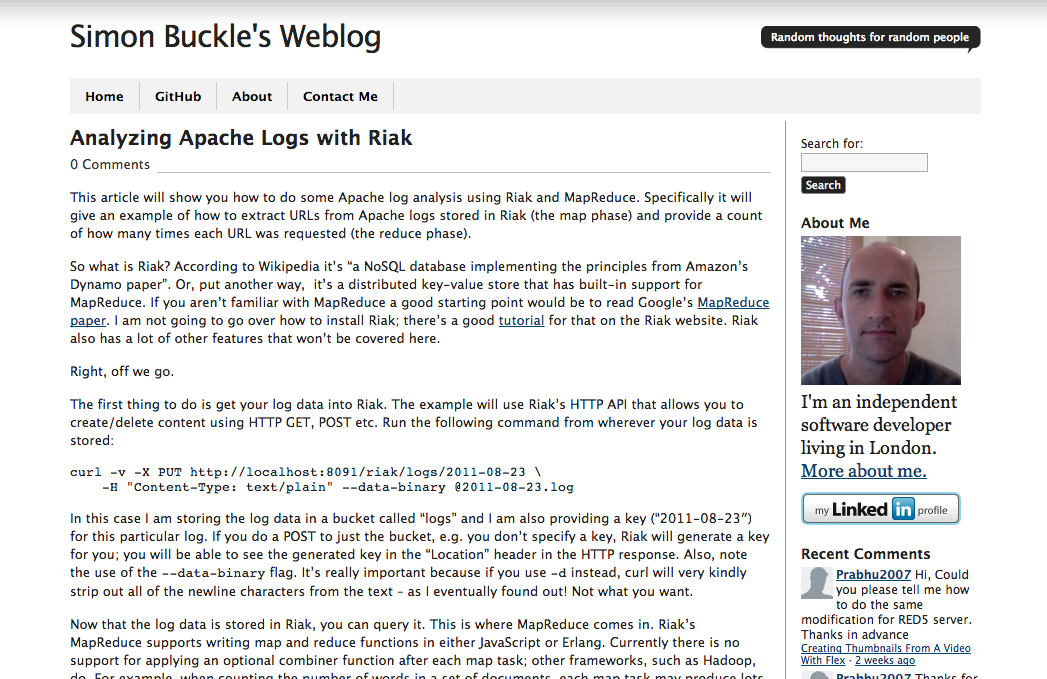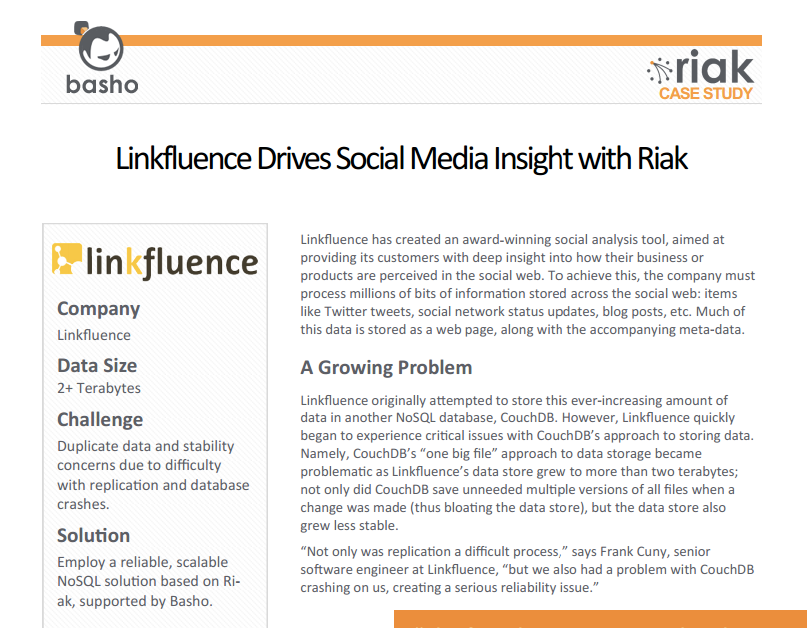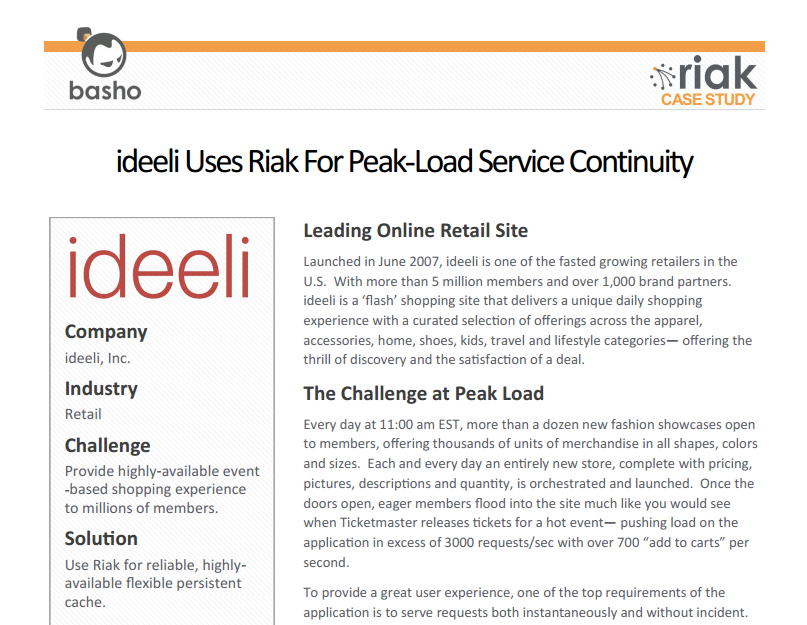Use Cases For Riak KV
Riak is a flexible data storage technology capable of addressing a wide variety of problems in a scalable way. In this guide, we’ll list a number of use cases and data models that are a good fit for Riak. All of these use cases are already being used in production for projects large and small. We’ll also suggest possibilities for implementation and provide links to videos and documentation for further exploration.
How you structure your application to run on Riak should take into account the unique needs of your use case, including access patterns such as read/write distribution, latency differences between various operations, use of Riak features including Data Types, MapReduce, Search, secondary indexes (2i), and more. This guide is intended to be illustrative only.
High Read/Write, Simple Applications
The following are examples of Riak use cases that require high read/write performance without necessarily utilizing complex data structures:
Content Management, Social Applications
The following application types require more subtle relationships between objects, e.g. one-to-many and many-to-many relationships.
- User Accounts
- User Settings and Preferences
- User Events and Timelines
- Articles, Blog Posts, and Other Content
Session Storage
Riak was originally created to serve as a highly scalable session store. This is an ideal use case for Riak, which is always most performant and predictable when used as a key/value store. Since user and session IDs are usually stored in cookies or otherwise known at lookup time, Riak is able to serve these requests with predictably low latency. Riak’s content-type agnosticism also imposes no restrictions on the value, so session data can be encoded in many ways and can evolve without administrative changes to schemas.
Complex Session Storage Case
Riak has features that allow for more complex session storage use cases. The Bitcask storage backend, for example, supports automatic expiry of keys, which frees application developers from implementing manual session expiry. Riak’s MapReduce system can also be used to perform batch processing analysis on large bodies of session data, for example to compute the average number of active users. If sessions must be retrieved using multiple keys (e.g. a UUID or email address), using secondary indexes can provide an easy solution.
Session Storage Community Examples

|
Scaling Riak at Kiip
In this talk, recorded at the May 2012 San Francisco Riak Meetup, Armon Dadgar and Mitchell Hashimoto of Kiip give an overview of how and why they are using Riak in production, and the road they took to get there. One of the first subsystems they switched over to Riak was Sessions. You can also read the blog post and catch the slides here. |
Serving Advertisements
Riak is often a good choice for serving advertising content to many different web and mobile users simultaneously with low latency. Content of this sort, e.g. images or text, can be stored in Riak using unique generated either by the application or by Riak. Keys can be created based on, for example, a campaign or company ID for easy retrieval.
Serving Advertisements Complex Case
In the advertising industry, being able to serve ads quickly to many users and platforms is often the most important factor in selecting and tuning a database. Riak’s tunable apps replication properties can be set to favor fast read performance. By setting R to 1, only one of N replicas will need to be returned to complete a read operation, yielding lower read latency than an R value equal to the number of replicas (i.e. R=N). This is ideal for advertising traffic, which primarily involves serving reads.
Serving Advertisements Community Examples

|
Riak at OpenX
Los Angeles-based OpenX will serves trillions of ads a year. In this talk, Anthony Molinaro, Engineer at OpenX, goes in depth on their architecture, how they've built their system, and why/how they're switching to Riak for data storage after using databases like CouchDB and Cassandra in production. |
Log Data
A common use case for Riak is storing large amounts of log data, either for
analysis using MapReduce or as a storage system used
in conjunction with a secondary analytics cluster used to perform more advanced
analytics tasks. To store log data, you can use a bucket called logs (just to
give an example) and use a unique value, such as a date, for the key. Log files
would then be the values associated with each unique key.
For storing log data from different systems, you could use unique buckets for
each system (e.g. system1_log_data, system2_log_data, etc.) and write
associated logs to the corresponding buckets. To analyze that data, you could
use Riak’s MapReduce system for aggregation tasks, such as summing the counts of
records for a date or Riak Search for a more robust, text-based queries.
Log Data Complex Case
For storing a large amount of log data that is frequently written to Riak, some users might consider doing primary storage of logs in a Riak cluster and then replicating data to a secondary cluster to run heavy analytics jobs, either over another Riak cluster or another solution such as Hadoop. Because the access patterns of reading and writing data to Riak is very different from the access pattern of something like a MapReduce job, which iterates over many keys, separating the write workload from the analytics workload will let you maintain higher performance and yield more predictable latency.
Log Data Community Examples

|
Simon Buckle on analyzing Apache logs with Riak. |
Sensor Data
Riak’s scalable design makes it useful for data sets, like sensor data, that scale rapidly and are subject to heavy read/write loads. Many sensors collect and send data at a given interval. One way to model this in Riak is to use a bucket for each sensor device and use the time interval as a unique key (i.e. a date or combination of date and time), and then store update data as the value.
That data could then be queried on the basis of the interval. Alternatively, a timestamp could be attached to each object as a secondary index, which would allow you to perform queries on specific time interval ranges or to perform MapReduce queries against the indexes.
Sensor Data Complex Case
If you are dealing with thousands or millions of sensors yet with very small data sets, storing all of a single device’s updates as unique keys may be cumbersome when it comes to reading that device’s data. Retrieving it all would mean calling a number of keys.
Instead, you could store all of a device’s updates in a document with a unique key to identify the device. Stored as a JSON document, you could read and parse all of those updates on the client side. Riak, however, doesn’t allow you to append data to a document without reading the object and writing it back to the key. This strategy would mean more simplicity and performance on the read side as a tradeoff for slightly more work at write time and on the client side.
It’s also important to keep an eye out for the total size of documents as they grow, as we tend to recommend that Riak objects stay smaller than 1-2 MB and preferably below 100 KB. Otherwise, performance problems in the cluster are likely.
User Accounts
User accounts tend to rely on fairly straightforward data models. One way of
storing user account data in Riak would be store each user’s data as a JSON
object in a bucket called users (or whatever you wish). Keys for user data
objects could be constructed using application-specific considerations. If your
application involves user logins, for example, the simplest and most read-
efficient strategy would be to use the login username as the object key. The
username could be extracted upon login, and a read request could be performed on
the corresponding key.
There are, however, several drawbacks to this approach. What happens if a user wants to change their username later on? The most common solution would be to use a UUID-type key for the user and store the user’s username as a secondary index for efficient lookup.
User Accounts Complex Case
For simple retrieval of a specific account, a user ID (plus perhaps a secondary index on a username or email) is enough. If you foresee the need to make queries on additional user attributes (e.g. creation time, user type, or region), plan ahead and either set up additional secondary indexes or consider using Riak Search to index the JSON contents of the user account.
User Accounts Community Examples

|
Riak at Braintree
Ben Mills, a developer at Braintree, discusses how their backend team came to find and begin to integrate Riak into their production environment. They also cover their model and repository framework for Ruby, Curator. Check out more details and slides on the Riak blog. |
User Settings and Preferences
For user account-related data that is simple and frequently read but rarely changed (such as a privacy setting or theme preference), consider storing it in the user object itself. Another common pattern is to create a companion user settings-type of object, with keys based on user ID for easy one-read retrieval.
User Settings and Preferences Complex Case
If you find your application frequently writing to the user account or have dynamically growing user-related data such as bookmarks, subscriptions, or multiple notifications, then a more advanced data model may be called for.
User Events and Timelines
Sometimes you may want to do more complex or specific kinds of modeling user
data. A common example would be storing data for assembling a social network
timeline. To create a user timeline, you could use a timeline bucket in Riak
and form keys on the basis of a unique user ID. You would store timeline
information as the value, e.g. a list of status update IDs which could then be
used to retrieve the full information from another bucket, or perhaps containing
the full status update. If you want to store additional data, such as a
timestamp, category or list of properties, you can turn the list into an array
of hashes containing this additional information.
Note than in Riak you cannot append information to an object, so adding events in the timeline would necessarily involve reading the full object, modifying it, and writing back the new value.
User Events and Timelines Community Examples

|
Riak at Yammer
This video was recorded at the March 2012 San Francisco Riak Meetup and is worth every minute of your time. Coda Hale and Ryan Kennedy of Yammer give an excellent and in depth look into how they built “Streamie”, user notifications, why Riak was the right choice, and the lessons learned in the process. Read more and get the slides in the Riak blog here. |

|
Riak at Voxer
The team at Voxer has long relied on Riak as their primary data store for various production services. They have put Riak through its paces and have served as one of our more exciting customers and use cases: Riak was in place when they shot to the top of the App Store at the end of 2011. We also love them because they open-sourced their Node.js client. Read more and get the slides in the Riak blog here. |
Articles, Blog Posts, and Other Content
The simplest way to model blog posts, articles, or similar content is to use a
bucket in Riak with some unique attribute for logical division of content, such
as blogs or articles. Keys could be constructed out of unique identifiers
for posts, perhaps the title of each article, a combination of the title and
data/time, an integer that can be used as part of a URL string, etc.
In Riak, you can store content of any kind, from HTML files to plain text to JSON or XML or another document type entirely. Keep in mind that data in Riak is opaque, with the exception of Riak Data Types, and so Riak won’t “know” about the object unless it is indexed using Riak Search or using secondary indexes.
Articles et al Complex Case
Setting up a data model for content becomes more complex based on the querying and search requirements of your application. For example, you may have different kinds of content that you want to generate in a view, e.g. not just a post but also comments, user profile information, etc.
For many Riak developers, it will make sense to divide content into different buckets, e.g. a bucket for comments that would be stored in the Riak cluster along with the posts bucket. Comments for a given post could be stored as a document with the same key as the content post, though with a different bucket/key combination. Another possibility would be to store each comment with its own ID. Loading the full view with comments would require your application to call from the posts and comments buckets to assemble the view.
Other possible cases may involve performing operations on content beyond key/value pairs. Riak Search is recommended for use cases involving full-text search. For lighter-weight querying, using secondary indexes (2i) enables you to add metadata to objects to either query for exact matches or to perform range queries. 2i also enables you to tag posts with dates, timestamps, topic areas, or other pieces of information useful for later retrieval.
Articles et al Community Examples

|
Linkfluence case study on using Riak to store social web content. |

|
ideeli case study on serving web pages with Riak. |
